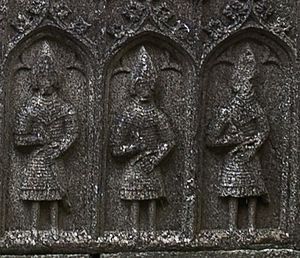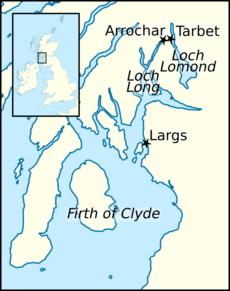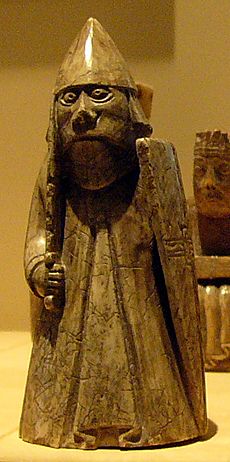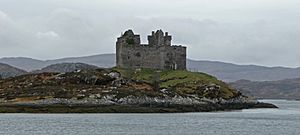Ailéan mac Ruaidhrí facts for kids
Quick facts for kids
Ailéan mac Ruaidhrí
|
|
|---|---|

The names of Ailéan and his brother, Dubhghall, as they appear on folio 122v of AM 45 fol (Codex Frisianus): "Aleinn broðir Dvggals konvngs". The excerpt notes the brothers' kinship and styles Dubhghall a king.
|
|
| Died | ×1296 |
| Noble family | Clann Ruaidhrí (Clann Somhairle) |
| Spouse(s) | Isabella |
| Issue | Lachlann, Ruaidhrí, and Cairistíona |
| Father | Ruaidhrí mac Raghnaill |
Ailéan mac Ruaidhrí (died around 1296) was an important leader in the 1200s. He lived in the Kingdom of the Isles and Kingdom of Scotland. Ailéan was the son of Ruaidhrí mac Raghnaill. This made him a member of the Clann Ruaidhrí family branch, which was part of the larger Clann Somhairle.
Ailéan was the brother of Dubhghall mac Ruaidhrí, King of Argyll and the Isles. Dubhghall was a powerful figure in the mid-1200s. At this time, the rulers of the Isles were very independent from Scotland. They mostly answered to the distant King of Norway. In 1259, Dubhghall's daughter married the son of the King of Connacht in Ireland. Ailéan was in charge of her dowry, which included 160 gallowglass warriors. Gallowglasses were a type of heavily armed soldier.
In the 1260s, Scotland started to take more control of the Isles. Dubhghall and Ailéan strongly supported Norway. Both brothers played a big part in Norway's fight against the Scots in 1263. After Norway's plan failed, they agreed to give the Isles to Scotland. Dubhghall kept fighting the Scots later that decade. But Ailéan and most of his family joined the Scottish kingdom. In 1275, Ailéan helped stop a revolt on the Isle of Man. In 1284, he joined a meeting about who would be the next Scottish king. These events show that his family became part of Scotland.
Contents
The Clann Ruaidhrí Family
Ailéan and his brother, Dubhghall, were sons of Ruaidhrí mac Raghnaill, Lord of Kintyre. Their father, Ruaidhrí, gave his name to the family group called Clann Ruaidhrí. This family was a branch of the larger Clann Somhairle. In the early 1200s, Ruaidhrí fought in Ireland with Thomas fitz Roland, Earl of Atholl. Thomas was the younger brother of Alan fitz Roland, Lord of Galloway. The close ties between these families might explain Ailéan's name.
In 1247, a leader from Clann Somhairle was killed fighting an English invasion in Ireland. The next year, Ailéan's brother Dubhghall and his cousin Eoghan Mac Dubhghaill traveled to Norway. Both men wanted to be king of the northern Suðreyjar, or Southern Isles. The Suðreyjar included the Hebrides and the Isle of Man. It's not clear exactly which islands Dubhghall and Eóghan wanted to rule.

In 1248, the King of the Isles, Haraldr, died unexpectedly. So, King Hákon of Norway sent Eóghan to rule the Isles for a short time. But Eóghan was also an important Scottish noble. Scotland had tried to buy the Isles earlier. When Eóghan accepted Norway's offer, Alexander II, King of Scotland attacked Argyll in 1249. This was the main area of the Clann Dubhghaill family. The crisis ended when King Alexander II suddenly died in July 1249.
Eóghan lost his lands because of Scotland's invasion. This might have changed the power order within Clann Somhairle. Records from Iceland say that in the same year Eóghan was forced out, Dubhghall "took kingship" in the Isles. This could mean that Dubhghall and Eóghan shared power. Or it could mean Dubhghall took over from a weakened Eóghan.
A Leader of Gallowglass Warriors

In 1258, Ailéan's brother Dubhghall fought against the English in Connacht, Ireland. That same year, a big meeting took place. Aedh mac Felim Ó Conchobair, son of the King of Connacht, and Tadhg Ó Briain, son of the King of Thomond, gave up their claims to be High King of Ireland. They chose Brian Ó Néill, King of Tír Eoghain, as High King instead. Brian was fighting the English and was close allies with Aodh.
The next year, old Irish records say that Aodh traveled to Derry. He married Dubhghall's daughter. As part of her dowry (a gift given with the bride), Aodh received 160 gallowglass warriors. Ailéan himself led these warriors. This makes Ailéan one of the earliest known leaders of gallowglasses. This marriage alliance was part of a plan to fight English power in northwest Ireland.
Sadly, Tadhg died by 1259. In 1260, Aodh and Brian's forces were completely defeated in battle at Downpatrick. Brian was killed. Despite this loss, Irish lords started hiring more heavily armed soldiers from the Isles. These gallowglasses helped to balance the fighting power against the English knights. English knights were usually better than lightly armed Irish horsemen. Gallowglasses fought in ways that could stop the powerful charges of these knights. Ailéan's gallowglass unit might have fought at Downpatrick.
A Norwegian Supporter

When King Alexander II died in 1249, Scotland's invasion of Argyll and the Isles stopped. About ten years later, Alexander's son, Alexander III, King of Scotland, became old enough to rule. He decided to continue his father's plan to expand west. In 1262, after Scotland failed again to buy the Isles, the Scots attacked the people of Skye very cruelly. This made King Hákon of Norway very angry. He gathered a huge fleet, the biggest ever from Norway, to show his power over Scotland's western coast. In July 1263, this fleet sailed from Norway. By mid-August, Hákon had control of Shetland and Orkney. He also made Caithness surrender and then arrived in the Hebrides.
In early September, Hákon's fleet, with Norwegians and Islesmen, entered the Firth of Clyde. Talks between Scotland and Norway broke down. Old stories say that Magnús Óláfsson, King of Mann and the Isles, Dubhghall, Ailéan, Aonghus Mór Mac Domhnaill, and Murchadh Mac Suibhne led a group of soldiers. This group sailed into Loch Long, carried their ships over land into Loch Lomond, and attacked the area around the Lennox. This group had about 40 to 60 ships, a large part of Hákon's fleet.
Ailéan's actions were praised in the stories. It says he took hundreds of cattle and caused a lot of damage in mainland Scotland. Scottish records support this. They show that the Sheriff of Stirling spent money to keep "vigilant men" at Stirling Castle. This was when the Norwegian forces were in the area. It seems the Norwegians and Islesmen were attacking the lands of the Stewarts. By going into the Earldom of Lennox, they were also moving into the Earldom of Menteith.

Meanwhile, in early October, Hákon's main force fought the Scots at Largs. Then they went back to the Hebrides. Once they met up with the group from Loch Lomond, Hákon rewarded his supporters. Eóghan had refused to help Norway. So, Dubhghall and Ailéan were given his island territories. A man named Ruðri received Bute, and Murchadh got Arran.
Even though the stories say the operation was a great success, it actually failed. Hákon did not break Scotland's power. Instead, King Alexander III took action the next year. He led several invasions into the Isles and northern Scotland. Magnús Óláfsson quickly surrendered to Alexander III. This showed that Norway had completely lost its power in the Isles. But Dubhghall refused to surrender to Scotland. In 1266, almost three years after Hákon's failed campaign, Scotland and Norway finally agreed to peace. The Treaty of Perth was signed in July. Hákon's son, Magnús Hákonarson, King of Norway, officially gave up all rights to Mann and the islands off Scotland's west coast. This finally settled the land dispute.
A Scottish Supporter
After Scotland gained the Isles, and Dubhghall died, the Clann Ruaidhrí family disappeared from Scottish records for a while. They reappeared in 1275, with Ailéan as an important Scottish noble. That year, records show that Guðrøðr Magnússon led a revolt on the Isle of Man against Scotland. King Alexander III sent a huge fleet from the Hebrides and Galloway to invade the island. He wanted to restore Scottish rule. The records say that two leaders were from Clann Somhairle: Alasdair Mac Dubhghaill, Lord of Argyll, and Ailéan himself. They were likely in charge of providing soldiers and ships from the Hebrides and Argyll. The Scots crushed the rebels. This revolt was a serious threat to Scotland's power. The fact that Clann Somhairle helped Scotland shows how much they had become part of the Scottish kingdom.
Important leaders from the west, like Ailéan, did not often visit the Scottish royal court. But sometimes they took part in important government matters. For example, in 1284, Ailéan was one of many men who attended a council at Scone. This meeting recognized Margaret, Maid of Norway, King Alexander III's granddaughter, as the rightful heir to the throne. Ailéan's presence, along with two other Clann Somhairle relatives, showed that the family was now part of the Scottish government.

It is thought that Dubhghall's main power base was in Garmoran and perhaps Uist. But it's not clear how and when his family got these lands. Later Clann Ruaidhrí leaders certainly owned them. But there is no proof they had them before the mid-1200s. These lands might have been given to the family after Scotland took the Isles in 1266. Or the family's power in the Isles might have come from their marriage ties with another powerful family. If the family got Uist after 1266, it could explain Ailéan's role in stopping the Manx revolt. Ailéan is not given any special title in the records of his time.
In 1282, a list of government papers shows that the Scottish King received a letter from the Norwegian King about the lands of Uist and Eigg. We don't know anything else about this letter. It might mean there was a dispute over the islands. Perhaps Clann Ruaidhrí members asked the Norwegian King for help. In 1285 or 1286, a servant of the King of Spain accused Ailéan of piracy in the Hebrides.
Ailéan is last mentioned in records around 1296. He likely died before this date. After his death, and before King Alexander III died, Ailéan's wife Isabella married Ingram de Umfraville. Ailéan had three children. His sons, Lachlann and Ruaidhrí, were born outside of marriage. His daughter, Cairistíona, was born within marriage. It's possible Cairistíona's mother was Isabella. Cairistíona seemed to be Ailéan's heir. But her brothers likely took over soon after his death. Ailéan's family continued to be important in Scottish history into the 1300s.
Images for kids



